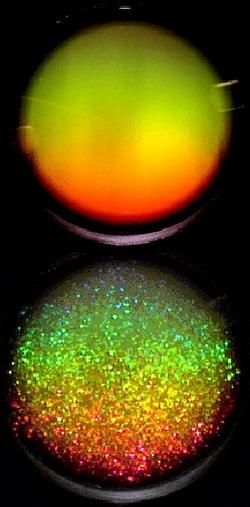Crystal Cannibals

The crystallization process that turns a liquid to a solid is brutally competitive, according to an analysis of experiments performed on the Space Shuttle. Researchers studied crystal-forming plastic beads immersed in liquid and found that the larger crystals cannibalize their smaller neighbors over surprisingly large distances. Experts hope the results, appearing in the 7 January print issue of PRL, will lead to a better understanding of crystallization, which is important in many industries.
Despite years of study, researchers still don’t fully understand the crystallization process. A better understanding might have benefits in chemical technology, pharmaceutics, protein research, and metallurgy, all of which often deal with crystallizing fluids.
Real crystallization happens rapidly when a liquid is frozen, so some condensed matter physicists instead study so-called hard sphere colloids–oily liquids filled with plastic spheres less than a micrometer in diameter. Under the right conditions–such as a fairly high bead density–these beads slowly form crystals, starting with tiny seeds called crystallites. Colloid crystals can be studied with visible light, instead of the more complex x-ray diffraction techniques that real crystals require, and they are easier to model theoretically, because the beads don’t interact at all, except when they bump into one another.
The only trouble with colloids is gravity: Any mismatch between the density of the oil and that of the bead material can cause the beads to sink or float–disrupting the crystallization process. To counteract this and other unwelcome gravity effects, Paul Chaikin of Princeton University and his colleagues put their experiment aboard the Space Shuttle. For two weeks, a video camera recorded light scattering from eight samples of hard sphere colloids during crystallization. The team found that while the crystallites grew in size, the number of crystallites decreased, suggesting that larger crystals gobbled up the smaller ones.
A similar effect occurs late in the crystallization process of either real crystals or beads. Since small crystallites have curvier surfaces than larger ones, they have relatively more surface area and more particles on their surfaces, where beads are less tightly bound. These weakly bound beads are easily snatched away by larger crystallites. Researchers expected to see this cannibalizing effect in their microbead colloid, but not when the crystals were small and far apart, says team member Zhengdong Cheng, now at DiCon Fiberoptics in Richmond, CA.
The team suggests that a kind of direct transport from the immediate neighborhoods of small crystallites to those of big ones must be at work. Perhaps large crystallites snatch beads from smaller ones when they happen to drift close enough to one another. While only some pairs of crystallites may have this interaction, says Princeton team member William Russell, it might be common enough to explain the results.
“It’s a surprising result,” says Peter Pusey of the University of Edinburgh in the United Kingdom. “You wouldn’t expect the crystallites to interact this early during crystallization.” Henk Lekkerkerker of the University of Utrecht in the Netherlands is not so sure about the explanation, however. He agrees that the observations contradict standard theory, but he wants to see more investigation aimed at clarifying the cause.
–Bruno van Wayenburg
Bruno van Wayenburg is a freelance science writer in Leiden, the Netherlands.


